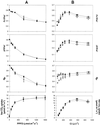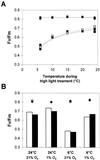Overexpression of iron superoxide dismutase in transformed poplar modifies the regulation of photosynthesis at low CO2 partial pressures or following exposure to the prooxidant herbicide methyl viologen
- PMID: 9625709
- PMCID: PMC34976
- DOI: 10.1104/pp.117.2.565
Overexpression of iron superoxide dismutase in transformed poplar modifies the regulation of photosynthesis at low CO2 partial pressures or following exposure to the prooxidant herbicide methyl viologen
Abstract
Chloroplast-targeted overexpression of an Fe superoxide dismutase (SOD) from Arabidopsis thaliana resulted in substantially increased foliar SOD activities. Ascorbate peroxidase, glutathione reductase, and monodehydroascorbate reductase activities were similar in the leaves from all of the lines, but dehydroascorbate reductase activity was increased in the leaves of the FeSOD transformants relative to untransformed controls. Foliar H2O2, ascorbate, and glutathione contents were comparable in all lines of plants. Irradiance-dependent changes in net CO2 assimilation and chlorophyll a fluorescence quenching parameters were similar in all lines both in air (21% O2) and at low (1%) O2. CO2-response curves for photosynthesis showed similar net CO2-exchange characteristics in all lines. In contrast, values of photochemical quenching declined in leaves from untransformed controls at intercellular CO2 (Ci) values below 200 microL L-1 but remained constant with decreasing Ci in leaves of FeSOD transformants. When the O2 concentration was decreased from 21 to 1%, the effect of FeSOD overexpression on photochemical quenching at limiting Ci was abolished. At high light (1000 micromol m-2 s-1) a progressive decrease in the ratio of variable (Fv) to maximal (Fm) fluorescence was observed with decreasing temperature. At 6(o)C the high-light-induced decrease in the Fv/Fm ratio was partially prevented by low O2 but values were comparable in all lines. Methyl viologen caused decreased Fv/Fm ratios, but this was less marked in the FeSOD transformants than in the untransformed controls. These observations suggest that the rate of superoxide dismutation limits flux through the Mehler-peroxidase cycle in certain conditions.
Figures









References
-
- Asada K. Production and action of active oxygen species in photosynthetic tissues. In: Foyer CH, Mullineaux PM, editors. Causes of Photooxidative Stress and Amelioration of Defense Systems in Plants. Boca Raton, FL: CRC Press; 1994. pp. 77–104.
-
- Beauchamp C, Fridovich I. Superoxide dismutase: improved assays and an assay applicable to acrylamide gels. Anal Biochem. 1971;44:276–287. - PubMed
-
- Beyer W, Fridovich I. Assaying for superoxide dismutase activity: some large consequences of minor changes in conditions. Anal Biochem. 1987;161:229–566. - PubMed
-
- Bowler C, Van Camp W, Van Montagu M, Inzé D. Superoxide dismutase in plants. Crit Rev Plant Sci. 1994;13:199–218.
Publication types
MeSH terms
Substances
LinkOut - more resources
Full Text Sources
Molecular Biology Databases

